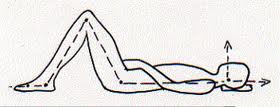Sedentary lifestyles, working from home, or in an office for prolonged periods of time without active breaks can start to build bad postural habits which may lead to aches and pains later in life. Let’s talk about your head and neck today and ask….Do you have forward head posture and if so, just how heavy is your head?
Do You Have Forward Head Posture?
Your head is like a bowling ball – for an adult it usually weighs around 10-12 lbs. However, for every inch that your head sits forward, it increases the weight of the head by approximately 10 lbs. If your head sits forward 3 inches, the forces acting on your neck and upper back are significantly increased, as if the head weighed close to 42 lbs. See the image below then look in the mirror and to compare your own posture:

That is a lot of weight for your spine to support for hours everyday. It is more than enough to cause a headache. If you’ve been getting neck and upper back fatigue or tightness throughout the day, postural dysfunctions and habits may be significantly contributing to your symptoms. We often call this repetitive micro trauma that builds up overtime “the straw that broke the camel’s back.”
Many times, complaints of upper shoulder and neck pain or numbness and tingling of the hands that clients claim they just “woke up with” are really manifestations of poor posture. This pain causes functional limitations like not being able to work out the way you did before or feeling limited in your daily life. If you are experiencing any pain that impacts your well-being or limits your activities of daily living, please come see one of our health care practitioners at CHARM to be evaluated and properly diagnosed. https://charmaustin.com/why-charm/the-team/
Ways to Combat Forward Head Posture
Today I just want to share 3 postural strategies and movement patterns that you can use throughout the day to prompt neutral neck and shoulder position in order to release tension in your body. Think of posture as the direction that you want to work towards, not a static position that you need to contort into:
- Find a neutral neck position when upright: think of someone pulling a string attached to the back of your skull, encouraging a gentle chin tuck. Often, our chins end up parallel to the ground, which is too high. Proper alignment of our high cervical spine releases and lengthens the suboccipital muscles on the back of your neck. See the visual below:

2. Practice the active rest position – lie down on your back with your knees bent and either a small pillow or a book under your head. Visualize melting into the floor, flattening your low back against the ground. This will lower your ribcage as you exhale and cause your chin to tuck gently. This is a much needed break for your neck that will help you destress and develop better posture.

3. Perform a gentle chest opener to release lat and pec muscle tightness. Place your hands on the counter while standing a couple feet away from it. Hinge at the hips, sinking them back until your back is parallel to the floor. Gently lengthen your finger tips forward. If you are very tight through the hamstrings, bend your knees. See below:

Practice these strategies for a couple minutes a day until it becomes second nature. If any positions are painful, please stop and consult one of our physical therapists. We will tailor a program based on your individual needs and goals.
References:
https://alexandertechnique.co.uk/alexander-technique
Lina Padegimaite, PT, DPT



